I usually hate high humidity. A lot. I grew up in Malaysia, the home of high humidity, and it was the bane of my existence. As a nerdy 14 year old, my pet peeve was stepping out of an air-conditioned place into the sticky night air, and having my glasses mist up immediately, blinding me instantly. I hated my glasses almost as much as the humidity when I was 14. But even now, after so many years when I should have gotten used to it, the humidity still gives me the shits. I get extremely cranky when the air is hot and heavy, much to the amusement of those around me. Apparently short, cranky people look funny. BUT. I do know one good thing about these hot sticky days. While they are almost the worst possible conditions for macaron baking, and are generally not too pleasant for having the oven on, they are perfect conditions for bread making. The warmth means you can prove your dough for the minimum amount of time and your dough will rise quickly and as perfectly as expected. So on one particularly humid day, I had the itch to make bread. And what better bread to make than the humble finger bun?
I LOVE finger buns. Fat, fluffy and pillow soft finger-shaped bread rolls, usually with sultanas in the dough, which are slathered in thick icing and topped with sprinkles, cinnamon or coconut. It's the ultimate Aussie treat to leave any child with a sticky face and hands, and on an intense sugar high. It beats a boring, greasy old doughnut any day in my opinion. I got caught up in the idea of making smaller versions of these huge finger buns, that you could quickly pop into your mouth. Usually when I get the craving for one of these I'll grab one from Baker's Delight and then gorge myself and feel incredibly sick afterwards, such is my lack of self control. I always like the idea of shrinking down the portion sizes of any dessert, it makes it easier to share and easier to stop yourself from going nuts and pigging out.
While searching for the perfect bun recipe for these finger bun bites, I happened to stumble upon this fantastic looking Japanese-style sweet bun dough recipe. I absolutely adore the light, fluffy texture of these sweet buns that you get from Asian bakeries, and I thought it might be interesting to try it with a finger bun. The recipe also uses an interesting technique I've never tried before, where you prepare a water-roux mixture to add to the dough, which is meant to give the bread some springiness. I adapted the recipe slightly, since I took some of the effort out by using my dough hook attachments on my hand mixer rather than hand kneading. If you don't have dough hooks, feel free to follow the original recipe instructions. One thing I would recommend you invest in is a thermometer, so that you can make your water roux just right, and also check that your wet ingredients are lukewarm and not too hot so that they won't kill the yeast. I use this IKEA meat thermometer for all my low (less than 130 degrees C) measurements, and a glass sugar thermometer (which only costs about 10 bucks) for all my high temperature measurements. It takes a lot of stress out of many cooking and baking processes and it's so cheap!
The recipe turned out just as I'd hoped, the dough was light and fluffy, almost cloud-like. Unfortunately I over-baked them slightly, so they turned out a bit drier and harder than I would have liked, but I did attempt some full sized buns which turned out amazing. So my advice to you if you do try the recipe is to make sure you don't over-bake them! I did half of the dough with sultanas (the ones with the white icing and sprinkles), and the other half plain (with pink icing and dessicated coconut). In hindsight, I think the best combination would have been to have all of them with sultanas AND coconut. I brought these along to Lex's trial run for the Time Out Taste Test, where he fed us the most awesome bah kuh teh, pork belly, scallops and celeriac mash. Thanks Lex!! I felt very spoilt. But I ate so much of Lex's dinner, I was completely stuffed by the time dessert was on the table. Also, with sticky date pudding and chocolate marquise to choose from, I didn't want to touch the finger bun bites! They were better saved for morning tea at work the next day, to help everyone get over their Monday-itis. I would love to try that bread recipe again with some Asian style fillings, but they did work pretty well as finger bun dough.
Sticky Finger Bun Bites
(adapted from this Japanese-Style Sweet Bun recipe)
325g bread flour (I found Lighthouse brand Bread & Pizza dough at the supermarket, not sure how important it is that you use this type of flour)
100g plain flour
35g milk powder
75g caster sugar
3/4 teaspoon salt
1 sachet (7g or 2 1/2 tsp) instant dry yeast
1 egg, lightly beaten
150ml (approx.) lukewarm water, adjust as necessary
40g butter, room temperature, cubed
25g (just under 2 tbsp) bread flour
125ml (1/2 cup) water
1 tbsp caster sugar + 2 tbsp warm milk, for glazing
Approx 500g icing sugar
Warm milk, around 1/4-1/2 cup, adjust as necessary
Dessicated coconut
Sultanas (approx 100 g)
Prepare the water-roux:
Combine 125ml water with 25g bread flour in a small saucepan. Cook over low to medium heat, stirring continuously until it reaches 65 degrees C. It should have thickened into a paste by this stage. Remove from the heat and cover saucepan with clingfilm. (If you don't have a thermometer, cook until it starts to thicken and then cook for about another minute before removing from the heat) This water roux can be kept in the fridge for up to a day in an airtight container, but do not use if it has turned grey in colour.
Prepare the bun dough:
Sift bread flour, plain flour, milk powder, caster sugar and salt into a large mixing bowl. Add instant dry yeast and mix well. Form a well into the centre and add egg and lukewarm water roux and mix in. Then, with an electric mixer and dough hooks on low speed, gradually add just enough lukewarm water to form into a slightly sticky, soft dough. Knead with dough hooks on about medium high speed for 10 minutes until smooth and elastic.
Knead in butter using dough hooks on high speed until well combined. The dough should be quite sticky and very elastic and will stretch like chewing gum when pulled.
Form into a ball and place in a large, greased bowl and cover with cling film. It should double in size (should take about 1 hour in warm weather, longer in winter months). Optimum room temperature for this first prove is 28°C with a humidity of 75%. To test if the dough has risen properly, dip a finger into bread or plain flour and poke down into the centre of the dough as far as your finger will go and pull out again – the hole should remain if it is ready. If the dough springs back, then it is not ready, continue to prove further.
Punch down, (add sultanas at this point if you want) knead briefly and form into a ball. Using your hands, form small balls of dough for the finger bun bites, approximately 3cm in diameter (try to keep any sultanas in the dough hidden under the surface of the balls, as they will expand in the oven). Place balls on 2-3 lined baking sheets, about 5cm apart and cover with clingfilm. Leave to double in size again (about 1 hour in warm weather, longer in winter months). Optimum room temperature for this final prove is 38°C with a humidity of 85%.
Bake in preheated 190°C oven for about 10-13 minutes, or until light golden brown.
When buns are nearly ready, dissolve caster sugar in warm milk. Remove buns from the oven and while still on the tray, brush the tops with the sweet milk glaze. Place to cool on a wire rack.
Sift icing sugar and gradually add warm milk until you it forms a very viscous, thick white paste. I found it was easier to add milk until it was too runny and then add additional sifted icing sugar to make it as thick as I want. It is thick enough when it can be spooned thickly onto the buns without dripping down the sides. Add any food colour you might want, and then cover each finger bun bite thickly in icing and dip the top into a bowl of dessicated coconut or sprinkles.
Leave to set on wire rack. Store in an airtight container, best eaten within a day but can also be stored in fridge for a couple of days and warmed up slightly in the microwave before eating.
I LOVE finger buns. Fat, fluffy and pillow soft finger-shaped bread rolls, usually with sultanas in the dough, which are slathered in thick icing and topped with sprinkles, cinnamon or coconut. It's the ultimate Aussie treat to leave any child with a sticky face and hands, and on an intense sugar high. It beats a boring, greasy old doughnut any day in my opinion. I got caught up in the idea of making smaller versions of these huge finger buns, that you could quickly pop into your mouth. Usually when I get the craving for one of these I'll grab one from Baker's Delight and then gorge myself and feel incredibly sick afterwards, such is my lack of self control. I always like the idea of shrinking down the portion sizes of any dessert, it makes it easier to share and easier to stop yourself from going nuts and pigging out.
While searching for the perfect bun recipe for these finger bun bites, I happened to stumble upon this fantastic looking Japanese-style sweet bun dough recipe. I absolutely adore the light, fluffy texture of these sweet buns that you get from Asian bakeries, and I thought it might be interesting to try it with a finger bun. The recipe also uses an interesting technique I've never tried before, where you prepare a water-roux mixture to add to the dough, which is meant to give the bread some springiness. I adapted the recipe slightly, since I took some of the effort out by using my dough hook attachments on my hand mixer rather than hand kneading. If you don't have dough hooks, feel free to follow the original recipe instructions. One thing I would recommend you invest in is a thermometer, so that you can make your water roux just right, and also check that your wet ingredients are lukewarm and not too hot so that they won't kill the yeast. I use this IKEA meat thermometer for all my low (less than 130 degrees C) measurements, and a glass sugar thermometer (which only costs about 10 bucks) for all my high temperature measurements. It takes a lot of stress out of many cooking and baking processes and it's so cheap!
The recipe turned out just as I'd hoped, the dough was light and fluffy, almost cloud-like. Unfortunately I over-baked them slightly, so they turned out a bit drier and harder than I would have liked, but I did attempt some full sized buns which turned out amazing. So my advice to you if you do try the recipe is to make sure you don't over-bake them! I did half of the dough with sultanas (the ones with the white icing and sprinkles), and the other half plain (with pink icing and dessicated coconut). In hindsight, I think the best combination would have been to have all of them with sultanas AND coconut. I brought these along to Lex's trial run for the Time Out Taste Test, where he fed us the most awesome bah kuh teh, pork belly, scallops and celeriac mash. Thanks Lex!! I felt very spoilt. But I ate so much of Lex's dinner, I was completely stuffed by the time dessert was on the table. Also, with sticky date pudding and chocolate marquise to choose from, I didn't want to touch the finger bun bites! They were better saved for morning tea at work the next day, to help everyone get over their Monday-itis. I would love to try that bread recipe again with some Asian style fillings, but they did work pretty well as finger bun dough.
Sticky Finger Bun Bites
(adapted from this Japanese-Style Sweet Bun recipe)
325g bread flour (I found Lighthouse brand Bread & Pizza dough at the supermarket, not sure how important it is that you use this type of flour)
100g plain flour
35g milk powder
75g caster sugar
3/4 teaspoon salt
1 sachet (7g or 2 1/2 tsp) instant dry yeast
1 egg, lightly beaten
150ml (approx.) lukewarm water, adjust as necessary
40g butter, room temperature, cubed
25g (just under 2 tbsp) bread flour
125ml (1/2 cup) water
1 tbsp caster sugar + 2 tbsp warm milk, for glazing
Approx 500g icing sugar
Warm milk, around 1/4-1/2 cup, adjust as necessary
Dessicated coconut
Sultanas (approx 100 g)
Prepare the water-roux:
Combine 125ml water with 25g bread flour in a small saucepan. Cook over low to medium heat, stirring continuously until it reaches 65 degrees C. It should have thickened into a paste by this stage. Remove from the heat and cover saucepan with clingfilm. (If you don't have a thermometer, cook until it starts to thicken and then cook for about another minute before removing from the heat) This water roux can be kept in the fridge for up to a day in an airtight container, but do not use if it has turned grey in colour.
Prepare the bun dough:
Sift bread flour, plain flour, milk powder, caster sugar and salt into a large mixing bowl. Add instant dry yeast and mix well. Form a well into the centre and add egg and lukewarm water roux and mix in. Then, with an electric mixer and dough hooks on low speed, gradually add just enough lukewarm water to form into a slightly sticky, soft dough. Knead with dough hooks on about medium high speed for 10 minutes until smooth and elastic.
Knead in butter using dough hooks on high speed until well combined. The dough should be quite sticky and very elastic and will stretch like chewing gum when pulled.
Form into a ball and place in a large, greased bowl and cover with cling film. It should double in size (should take about 1 hour in warm weather, longer in winter months). Optimum room temperature for this first prove is 28°C with a humidity of 75%. To test if the dough has risen properly, dip a finger into bread or plain flour and poke down into the centre of the dough as far as your finger will go and pull out again – the hole should remain if it is ready. If the dough springs back, then it is not ready, continue to prove further.
Punch down, (add sultanas at this point if you want) knead briefly and form into a ball. Using your hands, form small balls of dough for the finger bun bites, approximately 3cm in diameter (try to keep any sultanas in the dough hidden under the surface of the balls, as they will expand in the oven). Place balls on 2-3 lined baking sheets, about 5cm apart and cover with clingfilm. Leave to double in size again (about 1 hour in warm weather, longer in winter months). Optimum room temperature for this final prove is 38°C with a humidity of 85%.
Bake in preheated 190°C oven for about 10-13 minutes, or until light golden brown.
When buns are nearly ready, dissolve caster sugar in warm milk. Remove buns from the oven and while still on the tray, brush the tops with the sweet milk glaze. Place to cool on a wire rack.
Sift icing sugar and gradually add warm milk until you it forms a very viscous, thick white paste. I found it was easier to add milk until it was too runny and then add additional sifted icing sugar to make it as thick as I want. It is thick enough when it can be spooned thickly onto the buns without dripping down the sides. Add any food colour you might want, and then cover each finger bun bite thickly in icing and dip the top into a bowl of dessicated coconut or sprinkles.
Leave to set on wire rack. Store in an airtight container, best eaten within a day but can also be stored in fridge for a couple of days and warmed up slightly in the microwave before eating.

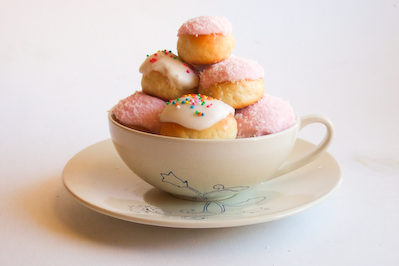

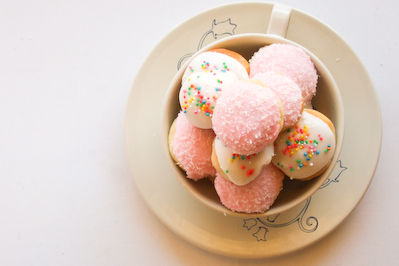
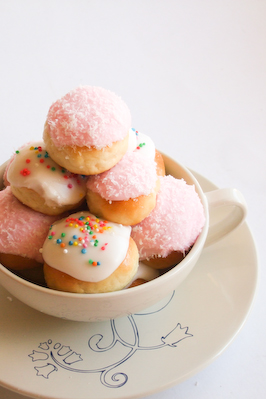
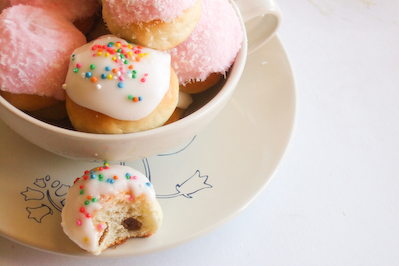
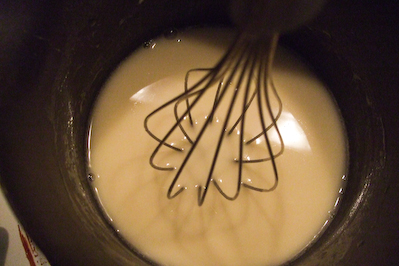
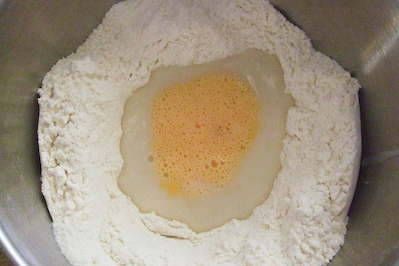
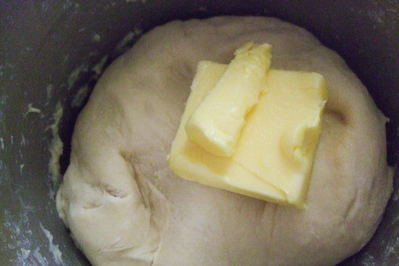
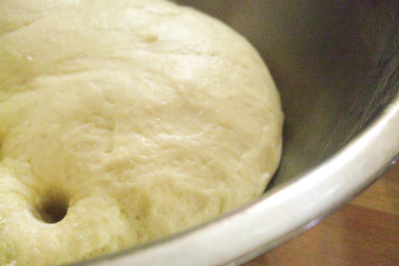
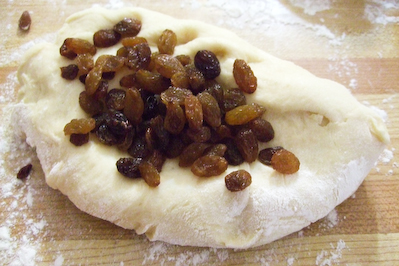
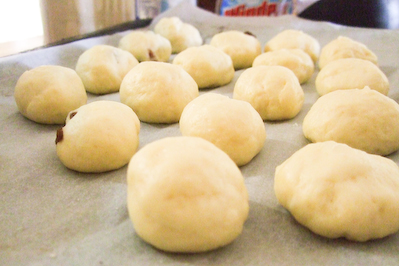
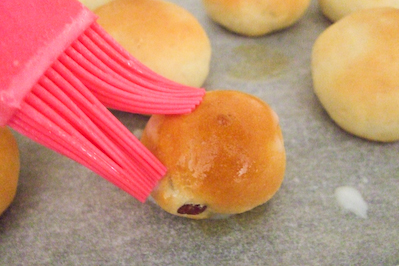
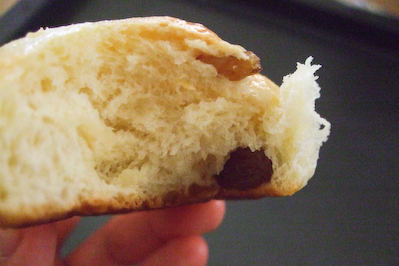
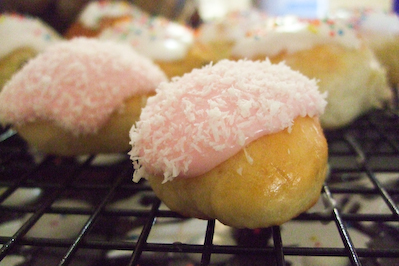
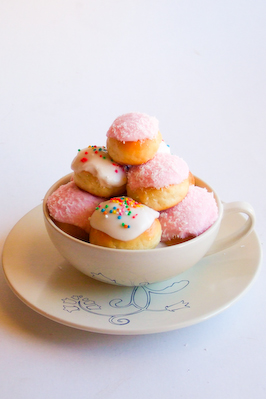





0 comments:
Post a Comment